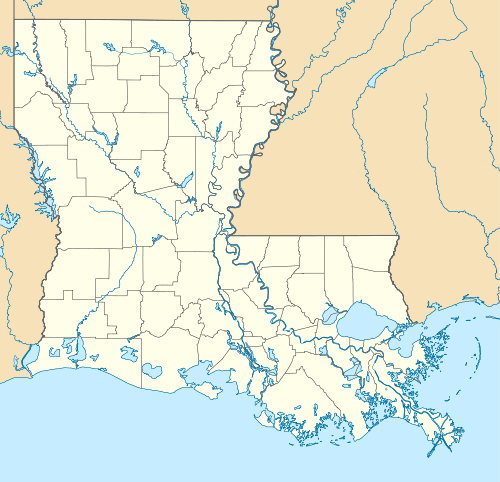LSU Campus Mounds
|
LSU Campus Indian Mounds | |
 | |
  | |
| Location | Jct. of Dalrymple Dr. and Fieldhouse Dr. on LSU campus, Baton Rouge, Louisiana |
|---|---|
| Coordinates | 30°24′54″N 91°10′53″W / 30.41500°N 91.18139°WCoordinates: 30°24′54″N 91°10′53″W / 30.41500°N 91.18139°W |
| Area | 2 acres (0.81 ha) |
| Architectural style | Earthen mounds |
| NRHP Reference # | [1] |
| Added to NRHP | March 01, 1999 |

The LSU Campus Mounds or LSU Indian Mounds are two Native American mounds, of the Archaic Period, on the campus of Louisiana State University in Baton Rouge, Louisiana. They are part of a larger, statewide system of mounds. They were probably used for "ceremonial and marking point purposes,"[2] rather than for burial purposes.[3] The 20 feet (6.1 m) tall mounds are thought to be more than 5,000 years old.[3][4] That date would make them part of the oldest mound system in North America, Mesoamerica or South America and also means they predate the building of the Great Pyramids of Egypt.[5]
Location and history
The mounds overlook the floodplain of the Mississippi River.[6] The northern mound consists of hard clay dirt; the southern mound is more porous.[2] They were first dated in 1982. Due to their location in a heavily trafficked area of campus, the mounds gradually began to show signs of degradation as well as natural erosion. In order to alleviate the issue, the university installed a sidewalk between the mounds in 1985. In addition, a low brick wall was placed around the mounds in order to prevent vehicles from dangerously crossing the mounds. Unfortunately, erosion continued to take its toll until a restoration project was initiated in 1996. Using river silt, the LSU Facility Services patched damage on both mounds and seeded a hybrid Bermuda grass to prevent future problems.[7] In 2009, LSU professor Brooks Ellwood took core samples that revealed a layer of charcoal, possibly from a pit barbecue or a cremation.[2] Since 1999 they are listed on the National Register of Historic Places.[8]
An archaeological excavation of the northern mound took place in spring of 2011.[9]
Folklore
Different stories about the origin of the mounds have circulated. One widespread myth was that the mounds were made of dirt dug up for the Huey P. Long pool on the LSU campus.[2] While archeologists do not believe they were burial mounds, another myth holds that the mounds are haunted by the ghosts of the dead.[10]
Save the Mounds
On September 30, 2010, LSU announced the "Save the Mounds" campaign to preserve the mounds. Officials from the school stated that the mounds had suffered internal structural damage that would lead to their eventual collapse.[9] While they were formerly used for tailgate parties, in 2010 they began to be fenced off during LSU's home football games to prevent them from being damaged.[11][12]
See also
References
- ↑ National Park Service (2009-03-13). "National Register Information System". National Register of Historic Places. National Park Service.
- 1 2 3 4 Blum, Jordan (16 April 2009). "Archaeologists test 'charcoal horizon' at LSU". The Advocate. Retrieved 14 January 2011.
- 1 2 Sternberg, Mary Ann (2001). Along the river road: past and present on Louisiana's historic byway. Baton Rouge: LSU Press. p. 208. ISBN 978-0-8071-2731-5.
- ↑ "LSU soil samples show Indian mounds 5,000 years old".
- ↑ "LSU Quick Facts". Retrieved 24 March 2011.
- ↑ Gleason, David K. (1991). Baton Rouge: Photographs and Text. LSU Press. p. 52. ISBN 978-0-8071-1715-6.
- ↑ "Indian Mounds--Louisiana". Indian Burial and Sacred Grounds Watch Home Page. Retrieved 2 March 2011.
- ↑ Blitzer, Carol Ann (10 December 2010). "LSU Mounds have storied past". The Advocate. Retrieved 14 January 2011.
- 1 2 Berthelot, Ashley. "Don't Tread on Me: University Takes Steps to Preserve LSU Mounds". Louisiana State University. Retrieved 14 January 2011.
- ↑ Tucker, Elizabeth (2007). Haunted halls: ghostlore of American college campuses. UP of Mississippi. p. 171. ISBN 978-1-57806-995-8.
- ↑ "LSU Indian mounds to be fenced off again on football game days". Associated Press. 1 October 2010. Retrieved 14 January 2011.
- ↑ "LSU tailgaters win over preservation at Indian mounds". The Advocate. 28 September 2010. Retrieved 14 January 2011.
External links
- LSU Indian Mounds by LSU Department of Geography and Anthropology
